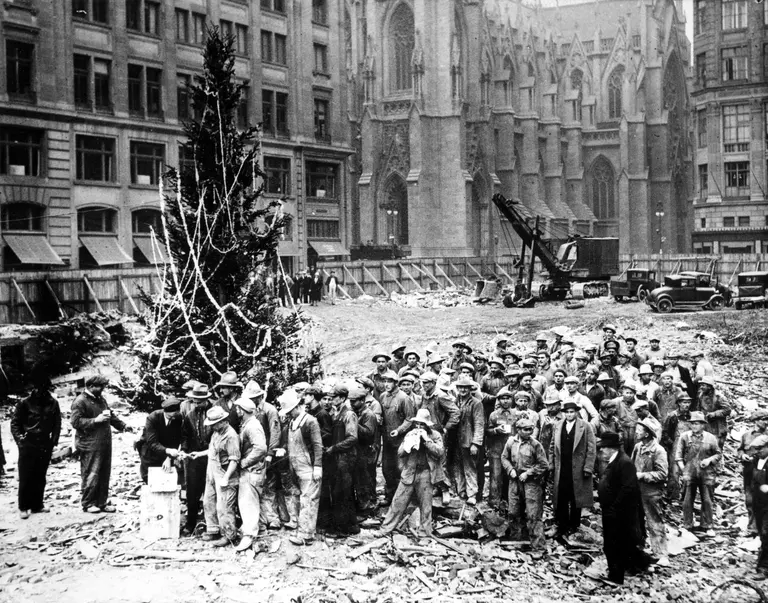In the 1980s a Group of Feisty Tenants Blocked Evictions by Donald Trump

It’s no secret that Donald Trump has engaged in some shady real estate dealings over the years, from his fraught attempt to own the Empire State Building, to the “public” gardens at Trump Tower that allowed him to build taller, to a lost battle with China over two major office buildings (not to mention his many bankruptcies). But there was at least one snafu that he wasn’t able to weasel himself out of, and it was all thanks to a group of feisty residential tenants.
In the early 1980s, Trump planned to evict rent-controlled and rent-stabilized tenants from 100 Central Park South (now known as Trump Parc East) and build a larger tower on this site and that of the adjacent Barbizon Plaza Hotel. He hired a management firm that specialized in emptying buildings, and they began eviction proceedings. After claiming reduced services, a lack of repairs, and overall harassment, the tenants decided to fight back, and in the end 80 percent of them remained, leading to this revelation by the Donald: “What I’ve learned is that the better the location and the lower the rent, the harder people fight. If I were a tenant, I’d probably be a leader too.”
A 1985 article in New York Magazine titled “The Cold War on Central Park South” by Tony Schwartz–the noted ghostwriter of Trump’s 1987 memoir “The Art of the Deal”– details how Trump housed homeless people in vacant units so that they could harass the tenants. As recently recounted in the New Yorker, Schwartz described him as a “fugue of failure, a farce of fumbling and bumbling,” and Trump loved it, even going so far as to hang the cover story up on his wall. “I was shocked,” Schwartz told New Yorker author Jane Mayer, “Trump didn’t fit any model of human being I’d ever met. He was obsessed with publicity, and he didn’t care what you wrote.”
It all started in 1981, when for a mere $13 million, Donald Trump bought 100 Central Park South and the Barbizon Plaza Hotel. He called it “one of the finest pieces of real estate in New York,” making clear his plans to build in their place a large tower fronting both Central Park South and 58th Street. It was easy to stop renting rooms at the hotel, but getting the tenants out of the 80 residential units was another story. Instead of offering hefty buyouts, which most certainly would have appealed to the rent-controlled tenants on low, fixed incomes, Trump hired Citadel Management to commence eviction proceedings, which, after three-and-a-half years, were still ongoing.
Among their tactics, Citadel hired agents to constantly call tenants, asking to show them other properties and convincing them that they’d have to move regardless. One of these agents admitted to doing the bare minimum one could legally get away with in terms of building upkeep. This included things like removing light covers, not cleaning up the lobby, barring doormen from carrying up packages, and putting aluminum foil on windows facing the park to give the building a rundown appearance (Trump’s camp claimed this was for security reasons).
But the tenants rallied together and hired lawyer David Rozenholc (who also notably helped a “hermit” tenant at 15 Central Park West get $17 million and a free apartment). In the case against Trump, the tenants at 100 Central Park South alleged harassment, but Trump flipped things, alleging that he was the one being harassed, as the well-to-do renters were lying to hold onto their Central Park Views, referring to them as “‘millionaires in mink coats, driving Rolls-Royces.” He said at the time:
Do you really think all these tenants would have stayed in the building if I did all they say I did? Let me tell you something about the rich. They have a very low threshold for pain. The fact is, if I’d ever really wanted to go hog-wild on this, if I wanted to turn off the heat and hot water and say my boiler had a big crack in it, which is what a lot of landlords do, then I would have lost 50 or 60 or 70 percent of the tenants in a month. I wouldn’t have done it on a moral basis, but if I didn’t have a reputation to protect, and if I didn’t have a bankroll where the fact that I’m losing a substantial amount of money on the building doesn’t affect my net worth, if I were a regular guy, I couldn’t go through this. I’d be forced to be either a desperate guy or a bad guy.”
Rozenholc had many key witnesses that he dispensed: a tenant whom Trump sued for non-payment, but was able to produce a cancelled check (evidence of continued harassment); a former building super who said he was told to spy on residents; and a group of tenants who received eviction notices for making alterations to their apartments, when those changes were approved by the previous landlord 10 to 20 years prior.
After a judge dismissed Trump’s $105 million countersuit, he finally dropped his construction plans in 1986, which allowed tenants to stay in their apartments paying their same rents. Fortunately or unfortunately, the long battle only increased the value of 100 Central Park South, and in the early 1990s, Trump converted much of it to condos. The renters remained, though, and even today, some are still renting units for under $1,000 a month.
RELATED:
Interested in similar content?
Leave a reply
Your email address will not be published.




























Those feisty, well-off tenants helped create the legal framework that has normalized the rights of rent-controlled and rent-stabilized tenants to this day. Then NY was bankrupt and seemed on an unstoppable downward spiral. No one could have imagined how wealthy NY would become in the years to come. It seemed unimaginable that the city would ever recover.